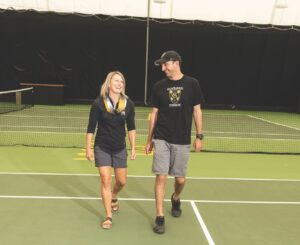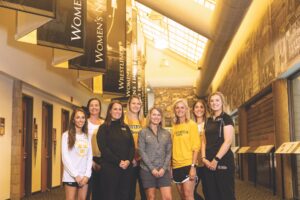Ask Nicole LaVoi ’91 her Gustavus major and she’ll laugh and say, “Tennis! I became passionate about women and girls empowerment through sport.”

The legendary Gustavus tennis coach, Steve Wilkinson, recruited the St. Cloud native to join the team as a first-year. That team “was a group of women that made no excuses,” LaVoi says. They won the NCAA Championship her junior year. LaVoi was inspired. After completing her health fitness and communications double major, she went on to coach tennis at Wellesley College (an all-women institution), earn a PhD in kinesiology at the University of Minnesota, and conduct research at the Center for Sport, Character & Culture at Notre Dame. Today she directs the Tucker Center for Research on Girls & Women in Sport.
When it was founded in 1993, the Tucker Center was the only research center of its kind in the world. LaVoi was at the starting line. As a grad student, she worked on the Center’s first groundbreaking report on sport for girls and women, released in 1997. Today, Tucker Center research spans Title IX and gender equity, physical activity and girls, media representation, and the women’s sports industry. Last July, the ninth annual Women in College Coaching Report Card was released with LaVoi’s graduate student advisees and fellow Gustie alums Courtney Boucher ’15 and Hanna Silva-Breen’18 sharing authorship. Its focus is to hold decision makers accountable for hiring practices. (New this year: data on racial identity and use of the word “gender” rather than “sex” to move away from binary assumptions.) In 2019, Gustavus professor Sarah Wolter ’02 released a co-authored longitudinal analysis of Division I media guides through the Tucker Center.
Here at the 50th anniversary of Title IX, where do we stand? As LaVoi is known for saying, “The data tells the story.”
THE GOOD NEWS, AND THE NOT-SO-GOOD
“In two generations we’ve gone from girls and women hoping there is a team to girls and women hoping they’ll make the team,” LaVoi says. More participation means more girls and women get the physical and psychological benefits of sports, and the corresponding career, relationship, and life satisfaction and success.
And yet, though there have been slight increases, the number of women coaching and leading sports has not risen on par with the growth in participation. Neither has media coverage of women’s sports. Not even close, in fact.
Why? “The simple answer is it’s about power.” With coaching, “it’s not that we have less qualified women or women who don’t want those positions. It’s about the opportunity that women are given to have access to positions of power that are controlled by men.” With media coverage, it’s her oft-repeated mantra: “If you show it, they will come.”
NEXT MOVES
“The people at the top must change. They’re the ones that make the decisions, the policies, and the occupational culture that either supports and values women or does not.” First among many such decisions is a commitment to equal resources. “You’re going to have to double down and invest above and beyond,” she says.

Then there’s coverage. A surprising thing happened in 2020 during COVID-19. The Women’s Soccer League adopted a closed “bubble” model and was the first professional league to return to play. The WNBA followed with “the wubble” as well as a focus on social justice issues. Both leagues saw astronomical increases in viewership, social media engagement, marketing, and platform streaming.
“People are finally realizing that this is an untapped, underserved market,” LaVoi says. “As we emerge from COVID, people see women’s sports as more aligned with values. When you watch you become a fan. When you become a fan you buy merchandise. This is what the Tucker Center has been arguing for decades.”
For the next five decades, LaVoi’s got clear targets. “I would like equal resources dedicated to women’s sport scholarships, participation opportunities, facilities, treatment, coverage, sponsorship, marketing, and viewership,” she says “I hope it doesn’t take 50 years to get there.”
And she’d like new defenders of Title IX to come along. “We need courage to make change among those who don’t want to.” If that’s you, “Welcome,” LaVoi says. ”There’s still more work to do.”